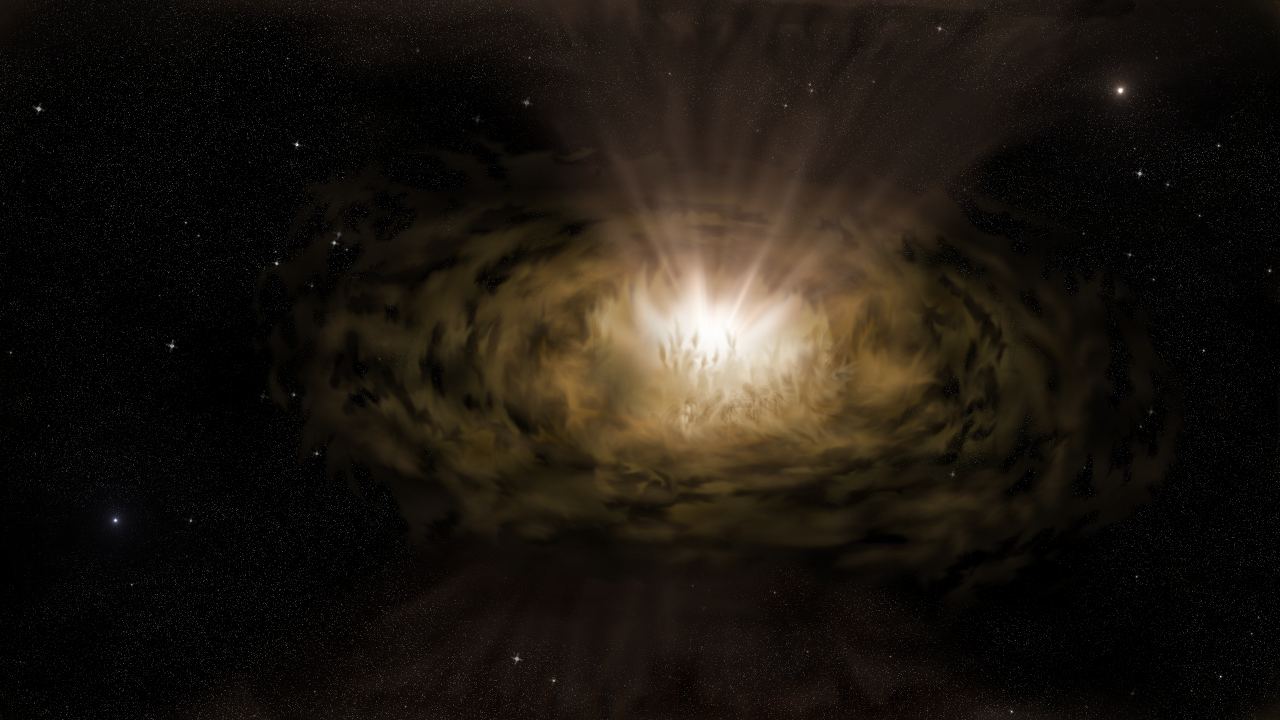

An artist’s impression of what the dust around a quasar might look like from a light year away. Credit Peter Z. Harrington
They are known as ultra-fast outflows (UFOs), powerful space winds emitted by the supermassive black holes (SMBHs) at the center of active galactic nuclei (AGNs) – aka. “quasars.” These winds (with a fun name!) move close to the speed of light (relativistic speeds) and regulate the behavior of SMBHs during their active phase. These gas emissions are believed to fuel the process of star formation in galaxies but are not yet well understood. Astronomers are interested in learning more about them to improve our understanding of what governs galactic evolution.
This is the purpose of the SUper massive Black hole Winds in the x-rAYS (SUBWAYS) project, an international research effort dedicated to studying quasars using the ESA’s XMM-Newton space telescope. The first results of this project were shared by a group of scholars led by the University of Bologna and the National Institute for Astrophysics (INAF) in Italy. In the paper that describes their findings, the team presented X-ray spectroscopic data to characterize the properties of UFOs in 22 luminous galaxies.
The SUBWAYS project is made up of astronomers and astrophysicists from the INAF, ESA’s European Space Astronomy Centre (ESAC), the Space Telescope Science Institute (STScI), the Space Science Data Center (SSDC), the Centro de Astrobiología (CSIC-INTA), the Center for Cosmology and Astroparticle Physics (CCAP), the NASA/Goddard Space Flight Center, the Netherlands Institute for Space Research (SRON), the Kavli Institute for Cosmology, the Max Planck-Institute for Extraterrestrial Physics, and multiple observatories and universities.
The paper, titled “Supermassive Black Hole Winds in X-rays: SUBWAYS,” recently appeared in the journal Astronomy & Astrophysics. As they described, the SUBWAYS team used the X-ray Multi-Mirror Mission (XMM) to analyze active galactic nuclei (AGN) for a period of more than 1.6 million seconds (eighteen days). These regions surrounding SMBHs emit tremendous amounts of radiation across the electromagnetic spectrum (when the black holes are active) to the point that they temporarily outshine all of the stars in the galaxy’s disk combined.
The extreme temperatures generated near SMBHs – up to tens of millions of degrees – also causes the material surrounding them to become highly ionized and emit radiation. The powerful winds arise when dust and gas in the SMBHs accretion disk are ejected outwards, transferring some of the material and energy into interstellar space. Research has shown that this mechanism has important implications for regulating the process of star formation,
To get a better look at UFOs, the team analyzed high-energy spectra emitted in the X-ray band by elements like iron. Their analysis included 17 AGNs located 1.5 to 5 billion light years away, to which they added data from 5 AGNs collected by previous observations. Their results showed that in about 30% of the AGNs analyzed, there are space winds traveling at speeds of 10% to 30% of the speed of light (0.1 to 0.3 c). Marcella Brusa, a professor at the University of Bologna and INAF associate, is the coordinator of the SUBWAYS project. As she explained in a UniBo Magazine press release:
“These results allow us to establish with greater certainty that a significant proportion of active galactic nuclei hosts ultra-fast winds called UFOs, ultra-fast outflows. And we were able to confirm that the intensity of these gas flows is sufficient to significantly change the ecosystem of their galaxies.”
Between an SMBH and the galaxy surrounding it, there is a reciprocal relationship where the two influence each other’s formation and evolution. While the mechanisms driving this relationship are not yet well understood, the ultra-fast wings emitted by AGNs are thought to play a vital role. Gabriele Matzeu, a researcher at the University of Bologna, INAF associate, and first author of the paper, summarized:
“These observations have allowed us to obtain new independent evidence of the existence of highly ionized matter that is ejected from the innermost regions of active galactic nuclei at speeds close to that of light. These outcomes have allowed us to learn more about these ultrafast winds and to better understand their role in shaping the evolution process of galaxies.”
Further Reading: UniBo Magazine
Astronomers have been battling threats to their clear skies on all fronts lately. One of…
If you were Captain of the first USS Enterprise, where would you go!? Humanity is…
Now is the best time to observe Mars in 2025. Mars from 2014. Credit: Paul…
Scheduled for launch in 2027, the Nancy Grace Roman Telescope is slowly being readied for…
Few places in the solar system are better suited to a balloon than Titan. The…
We reported before about a NIAC-funded project known as the Lofted Environment and Atmospheric Venues…